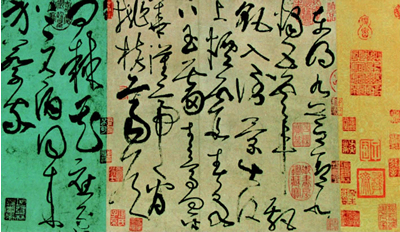Zhang Xu
Zhang Xu (710-750), also known as Zhang Changshi for his official post, was a native of today's Suzhou of Jiangsu Province. Zhang once served as a regional officer, drank wine to extremes and indulged fully in life's pleasures. He usually wrote crazily after drinking while also shouting and walking about. Records show he soaked his own hair with ink and used it to create a calligraphy work, thus earning himself the nickname "Crazy Zhang."
 Cursive Calligraphy by Zhang Xu (Tang Dynasty)
Cursive Calligraphy by Zhang Xu (Tang Dynasty)
Zhang enjoyed considerable fame in his day, and is counted among the Tang poet Du Fu's "Eight Drunken Immortals," together with other famous Tang poets, such as Li Bai and He Zhizhang .
Zhang was good at kaishu (regular script) and caoshu (cursive script), especially kuangcao (wild cursive script). While inheriting the calligraphic heritage of "Er Wangs (Wang Xizhi and Wang Xianzhi)," Zhang also added his original creation. His kaishu calligraphy, assuming a touch of the writing style of Ouyang Xun and Yu Shinan (both were kaishu masters of the Tang Dynasty ), looks dignified and vigorous, well exhibiting the subtleness of the kaishu style.
Zhang Xu's kuangcao calligraphy shows much diversity. According to a modern scholar, Han Yutao, Zhang's calligraphy works have three properties. First, they were wild. He always finished a calligraphic work in one sweep. Hence, when reading his calligraphy work, one can feel the momentum. Second, they were strange and always varied. Zhang's calligraphy is as unpredictable as his brushstrokes and character structures are unfathomable. Third, they were formidable. Previous Chinese calligraphic works had a slender beauty, while the calligraphy work of Zhang Xu makes the reader feel as if one's head were pressed down by stones. Reading Zhang's calligraphy, one may have the feeling of being threatened by a sword. Yet, he respects his dignity. Though Zhang Xu's kuangcao were wild and crazy, his brushstroke technique adhered to certain rules, and he was also proficient at the more restrained kaishu calligraphy. Only a few of Zhang Xu's works have remained to this day, and among the masterpieces are Gushi Sitie and Shiwuri Tie.
Source: suzhou.gov.cn
Editor: Feng Hui
|

